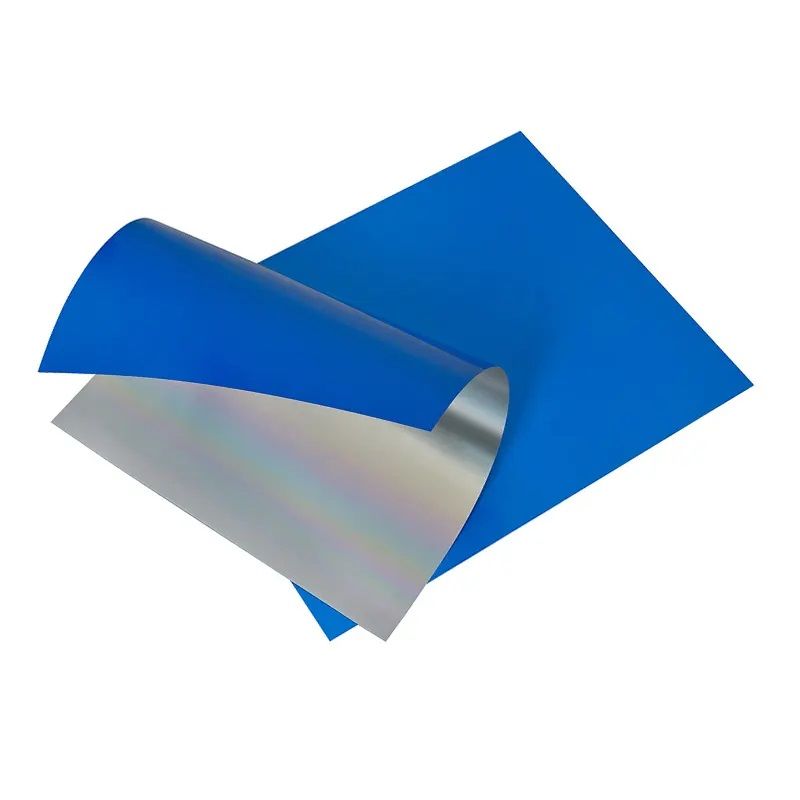
News
Thermal plates for offset printing are key consumables that achieve image transfer through thermal imaging technology. The core principle is to use thermal energy (laser heating) to cause physical or chemical changes in the plate coating to form a printed image area. The surface of the aluminum sheet substrate is coated with a thermal coating (containing microcapsules or wax-based materials). After laser heating, the coating in the image area melts or changes structure due to the increase in temperature (usually 60-120°C), forming an oleophilic surface (accepting ink), and the non-image area maintains hydrophilic properties (repelling ink), realizing the basic printing function.

Classification of thermal plates for offset printing:
1. By post-plate processing
- Wash free thermal plates:
No need for development and washing, directly on the machine after laser exposure, the process is extremely simple, and the environmental protection is high (no waste liquid discharge).
Suitable for short-run printing, fast proofing, and small-batch production.
- Wash-required thermal plates:
After exposure, they need to be treated with a developer (such as a water-based or weakly alkaline developer) to remove the coating in the non-image area, and the printing durability is higher.
Suitable for long-run printing and high-quality mass production.
2. According to coating materials
- Silver salt composite thermal plate:
With silver salt as the photosensitive core, the imaging accuracy is high (up to 2500dpi or more), but the cost is relatively high.
Suitable for high-end commercial printing and fine packaging.
- Resin thermal plate:
With thermal resin as the main component, it has high cost performance, is suitable for medium-precision requirements, and has moderate printing resistance.
Suitable for book printing and ordinary packaging.
3. According to base material
- Aluminum-based thermal plate:
Mainstream base, high hardness, strong printing resistance, suitable for most offset printing scenarios.
Suitable for commercial printing, newspapers, packaging.
- Polyester-based thermal plate:
Flexible base, light weight, easy to bend, suitable for printing on special curved surfaces or flexible substrates. Suitable for flexible packaging and label printing.
Core characteristics of thermal plates for offset printing:
- Imaging resolution and dot accuracy
The resolution is usually between 2400 and 4000 dpi, and can restore 1% to 99% of the dot range. It supports FM screening and AM screening to meet high-precision printing needs (such as image printing above 300 lines).
Case: In high-end cosmetic packaging printing, thermal plates can clearly present gradient colors and subtle textures, avoiding the dot blurring problem of traditional printing plates.
- Printing durability and wear resistance
Unbaked plates have a printing durability of about 50,000 to 100,000 times, and after baking (processed at about 200°C), it can reach 200,000 to 500,000 times, which is suitable for long-run printing of newspapers, textbooks, etc.
The coating has a dense structure after laser curing, and is not easily worn by ink and fountain solution during printing, reducing image distortion.
- Environmental adaptability
Insensitive to temperature and humidity (can work stably in an environment of 15-35℃ and 30%-70% humidity), avoiding the platemaking errors caused by darkroom operation or ambient light of traditional photopolymer plates.
The brightroom operation characteristics simplify the production process and improve efficiency (such as the platemaking workshop does not need to be shaded, and the platemaking process can be monitored in real time).
Application scenarios of thermal plates for offset printing:
1. Commercial printing
- High-end albums, magazines, posters:
Use high-resolution imaging to restore delicate colors and image details (such as skin color transitions in photographic albums and gradient levels in landscapes).
- Variable data printing:
Such as personalized invitations and advertising leaflets, rapid platemaking through thermal plates, adapting to small batches and multiple versions.
2. Packaging printing
- Food packaging, pharmaceutical packaging:
Meet anti-counterfeiting printing (such as microtext, special dot structure) and color consistency requirements (such as accurate restoration of Pantone colors of brand LOGO).
- Labels and flexible packaging:
Flexographic thermal plates can be adapted to curved surface printing, such as beverage bottle labels and aluminum foil packaging bags.
3. Publishing and printing
- Textbooks and supplementary teaching materials:
Maintain the clarity of images and texts in long-run printing and reduce the cost of changing plates in the middle (such as printing more than 100,000 textbooks at a time).
- Hardcover book covers:
Support accurate overprinting of post-processing processes such as hot stamping and UV glazing.
4. Special fields
- Bill and securities printing:
Use high-precision imaging of thermal plates to achieve anti-counterfeiting shading and micro-text printing (such as invoices and coupons).
- Circuit board printing:
In the production of flexible circuit boards (FPCs), thermal plates can be used to transfer fine lines with an accuracy of less than 50μm.
PRODUCTS
ONLINE CONSULTATION
If you have any questions, please contact us and we will contact you as soon as possible.
Leave A Message
If you are interested in our products and want to know more details, please leave a message here, we will reply you as soon as we can.

